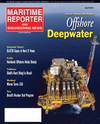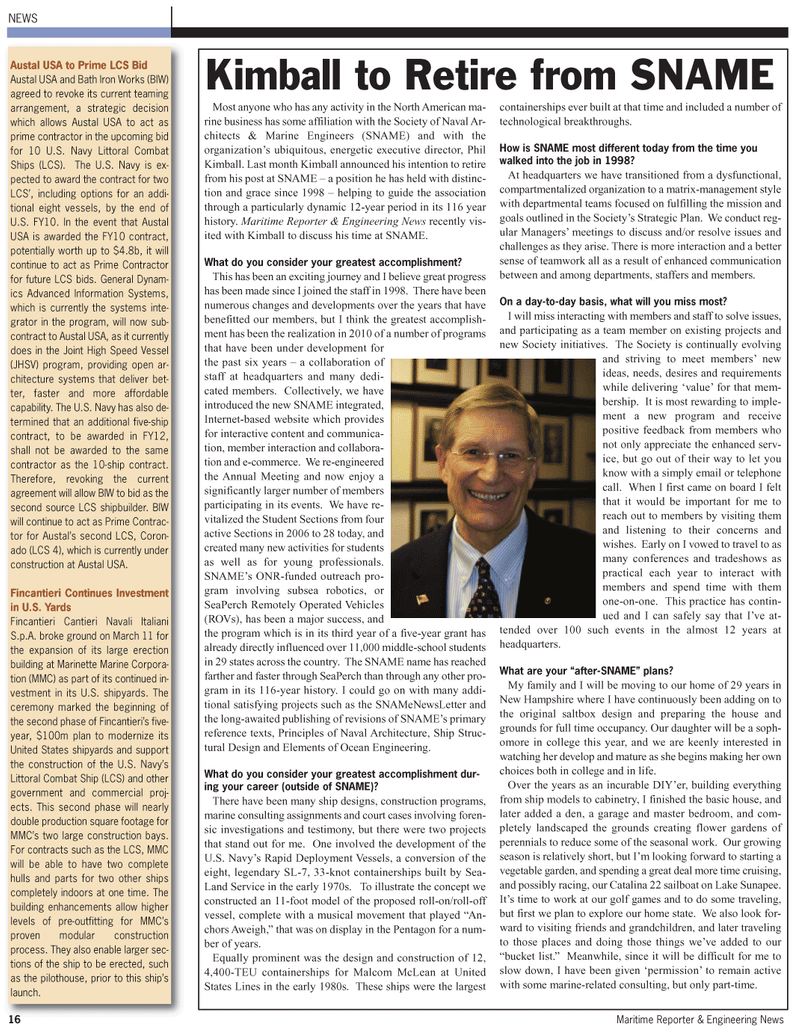
Page 16: of Maritime Reporter Magazine (April 2, 2010)
Read this page in Pdf, Flash or Html5 edition of April 2, 2010 Maritime Reporter Magazine
NEWS
Austal USA to Prime LCS Bid
Austal USA and Bath Iron Works (BIW) agreed to revoke its current teaming arrangement, a strategic decision which allows Austal USA to act as prime contractor in the upcoming bid for 10 U.S. Navy Littoral Combat
Ships (LCS). The U.S. Navy is ex- pected to award the contract for two
LCS’, including options for an addi- tional eight vessels, by the end of
U.S. FY10. In the event that Austal
USA is awarded the FY10 contract, potentially worth up to $4.8b, it will continue to act as Prime Contractor for future LCS bids. General Dynam- ics Advanced Information Systems, which is currently the systems inte- grator in the program, will now sub- contract to Austal USA, as it currently does in the Joint High Speed Vessel (JHSV) program, providing open ar- chitecture systems that deliver bet- ter, faster and more affordable capability. The U.S. Navy has also de- termined that an additional five-ship contract, to be awarded in FY12, shall not be awarded to the same contractor as the 10-ship contract.
Therefore, revoking the current agreement will allow BIW to bid as the second source LCS shipbuilder. BIW will continue to act as Prime Contrac- tor for Austal’s second LCS, Coron- ado (LCS 4), which is currently under construction at Austal USA.
Fincantieri Continues Investment in U.S. Yards
Fincantieri Cantieri Navali Italiani
S.p.A. broke ground on March 11 for the expansion of its large erection building at Marinette Marine Corpora- tion (MMC) as part of its continued in- vestment in its U.S. shipyards. The ceremony marked the beginning of the second phase of Fincantieri’s five- year, $100m plan to modernize its
United States shipyards and support the construction of the U.S. Navy’s
Littoral Combat Ship (LCS) and other government and commercial proj- ects. This second phase will nearly double production square footage for
MMC’s two large construction bays.
For contracts such as the LCS, MMC will be able to have two complete hulls and parts for two other ships completely indoors at one time. The building enhancements allow higher levels of pre-outfitting for MMC’s proven modular construction process. They also enable larger sec- tions of the ship to be erected, such as the pilothouse, prior to this ship’s launch.
Most anyone who has any activity in the North American ma- rine business has some affiliation with the Society of Naval Ar- chitects & Marine Engineers (SNAME) and with the organization’s ubiquitous, energetic executive director, Phil
Kimball. Last month Kimball announced his intention to retire from his post at SNAME – a position he has held with distinc- tion and grace since 1998 – helping to guide the association through a particularly dynamic 12-year period in its 116 year history. Maritime Reporter & Engineering News recently vis- ited with Kimball to discuss his time at SNAME.
What do you consider your greatest accomplishment?
This has been an exciting journey and I believe great progress has been made since I joined the staff in 1998. There have been numerous changes and developments over the years that have benefitted our members, but I think the greatest accomplish- ment has been the realization in 2010 of a number of programs that have been under development for the past six years – a collaboration of staff at headquarters and many dedi- cated members. Collectively, we have introduced the new SNAME integrated,
Internet-based website which provides for interactive content and communica- tion, member interaction and collabora- tion and e-commerce. We re-engineered the Annual Meeting and now enjoy a significantly larger number of members participating in its events. We have re- vitalized the Student Sections from four active Sections in 2006 to 28 today, and created many new activities for students as well as for young professionals.
SNAME’s ONR-funded outreach pro- gram involving subsea robotics, or
SeaPerch Remotely Operated Vehicles (ROVs), has been a major success, and the program which is in its third year of a five-year grant has already directly influenced over 11,000 middle-school students in 29 states across the country. The SNAME name has reached farther and faster through SeaPerch than through any other pro- gram in its 116-year history. I could go on with many addi- tional satisfying projects such as the SNAMeNewsLetter and the long-awaited publishing of revisions of SNAME’s primary reference texts, Principles of Naval Architecture, Ship Struc- tural Design and Elements of Ocean Engineering.
What do you consider your greatest accomplishment dur- ing your career (outside of SNAME)?
There have been many ship designs, construction programs, marine consulting assignments and court cases involving foren- sic investigations and testimony, but there were two projects that stand out for me. One involved the development of the
U.S. Navy’s Rapid Deployment Vessels, a conversion of the eight, legendary SL-7, 33-knot containerships built by Sea-
Land Service in the early 1970s. To illustrate the concept we constructed an 11-foot model of the proposed roll-on/roll-off vessel, complete with a musical movement that played “An- chors Aweigh,” that was on display in the Pentagon for a num- ber of years.
Equally prominent was the design and construction of 12, 4,400-TEU containerships for Malcom McLean at United
States Lines in the early 1980s. These ships were the largest containerships ever built at that time and included a number of technological breakthroughs.
How is SNAME most different today from the time you walked into the job in 1998?
At headquarters we have transitioned from a dysfunctional, compartmentalized organization to a matrix-management style with departmental teams focused on fulfilling the mission and goals outlined in the Society’s Strategic Plan. We conduct reg- ular Managers’ meetings to discuss and/or resolve issues and challenges as they arise. There is more interaction and a better sense of teamwork all as a result of enhanced communication between and among departments, staffers and members.
On a day-to-day basis, what will you miss most?
I will miss interacting with members and staff to solve issues, and participating as a team member on existing projects and new Society initiatives. The Society is continually evolving and striving to meet members’ new ideas, needs, desires and requirements while delivering ‘value’ for that mem- bership. It is most rewarding to imple- ment a new program and receive positive feedback from members who not only appreciate the enhanced serv- ice, but go out of their way to let you know with a simply email or telephone call. When I first came on board I felt that it would be important for me to reach out to members by visiting them and listening to their concerns and wishes. Early on I vowed to travel to as many conferences and tradeshows as practical each year to interact with members and spend time with them one-on-one. This practice has contin- ued and I can safely say that I’ve at- tended over 100 such events in the almost 12 years at headquarters.
What are your “after-SNAME” plans?
My family and I will be moving to our home of 29 years in
New Hampshire where I have continuously been adding on to the original saltbox design and preparing the house and grounds for full time occupancy. Our daughter will be a soph- omore in college this year, and we are keenly interested in watching her develop and mature as she begins making her own choices both in college and in life.
Over the years as an incurable DIY’er, building everything from ship models to cabinetry, I finished the basic house, and later added a den, a garage and master bedroom, and com- pletely landscaped the grounds creating flower gardens of perennials to reduce some of the seasonal work. Our growing season is relatively short, but I’m looking forward to starting a vegetable garden, and spending a great deal more time cruising, and possibly racing, our Catalina 22 sailboat on Lake Sunapee.
It’s time to work at our golf games and to do some traveling, but first we plan to explore our home state. We also look for- ward to visiting friends and grandchildren, and later traveling to those places and doing those things we’ve added to our “bucket list.” Meanwhile, since it will be difficult for me to slow down, I have been given ‘permission’ to remain active with some marine-related consulting, but only part-time.
Kimball to Retire from SNAME 16 Maritime Reporter & Engineering News

 15
15

 17
17
